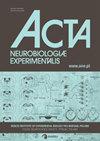The effect of morphine administration on GluN3B NMDA receptor subunit mRNA expression in rat brain
IF 1.4
4区 医学
Q4 NEUROSCIENCES
引用次数: 0
Abstract
Opioid addiction is critically dependent on the activation of N‑methyl‑D‑aspartate (NMDA) receptors, which are widely found in the mesocorticolimbic system. Meanwhile, opioid addiction may affect the expression level of NMDA receptor subunits. The existence of GluN3 subunits in the NMDA receptor’s tetramer structure reduces the excitatory current of the receptor channel. We evaluated the changes in the mRNA expression pattern of the GluN3B subunit of the NMDA receptor in rat brains following acute and chronic exposure to morphine. Chronic, escalating intraperitoneal doses of morphine or saline were administered twice daily to male Wistar rats for six days. Two other groups were injected with a single acute dose of morphine or saline. The mRNA level of the GluN3B subunit of the NMDA receptor in the striatum, hippocampus, and nucleus accumbens (NAc) was measured by real‑time PCR. mRNA expression of the GluN3B subunit was considerably augmented (3.15 fold) in the NAc of animals chronically treated with morphine compared to the control group. The difference between rats that were chronically administered morphine and control rats was not statistically significant for other evaluated brain areas. In rats acutely treated with morphine, no significant differences were found for GluN3B subunit expression in the examined brain regions compared to the control group. It was concluded that chronic exposure to morphine notably increased the GluN3B subunit of the NMDA receptor in NAc. The extent of the impact of this finding on opioid addiction and its features requires further evaluation in future studies.吗啡对大鼠脑内 GluN3B NMDA 受体亚基 mRNA 表达的影响
阿片类药物成瘾主要依赖于N-甲基-D-天冬氨酸(NMDA)受体的激活,而NMDA受体广泛存在于中皮质边缘系统。同时,阿片类药物成瘾可能会影响 NMDA 受体亚基的表达水平。NMDA 受体四聚体结构中 GluN3 亚基的存在会降低受体通道的兴奋电流。我们评估了急性和慢性吗啡暴露后大鼠大脑中 NMDA 受体 GluN3B 亚基 mRNA 表达模式的变化。给雄性 Wistar 大鼠腹腔注射慢性、递增剂量的吗啡或生理盐水,每天两次,连续六天。另外两组大鼠则注射了单次急性剂量的吗啡或生理盐水。与对照组相比,长期接受吗啡治疗的动物 NAc 中 GluN3B 亚基的 mRNA 表达量显著增加(3.15 倍)。长期服用吗啡的大鼠与对照组大鼠在其他评估脑区的差异没有统计学意义。在接受吗啡急性治疗的大鼠中,与对照组相比,检查脑区的 GluN3B 亚基表达没有发现显著差异。结论是,长期接触吗啡会显著增加北大西洋鳕鱼体内的 NMDA 受体 GluN3B 亚基。这一发现对阿片类药物成瘾及其特征的影响程度需要在今后的研究中进一步评估。
本文章由计算机程序翻译,如有差异,请以英文原文为准。
求助全文
约1分钟内获得全文
求助全文
来源期刊
CiteScore
2.20
自引率
7.10%
发文量
40
审稿时长
>12 weeks
期刊介绍:
Acta Neurobiologiae Experimentalis (ISSN: 0065-1400 (print), eISSN: 1689-0035) covers all aspects of neuroscience, from molecular and cellular neurobiology of the nervous system, through cellular and systems electrophysiology, brain imaging, functional and comparative neuroanatomy, development and evolution of the nervous system, behavior and neuropsychology to brain aging and pathology, including neuroinformatics and modeling.

 求助内容:
求助内容: 应助结果提醒方式:
应助结果提醒方式:


